American Journal of Physical Medicine 1964;44:55-69
The Concept of Painlessness and Opposite Motion in
Spinal Manipulations
Robert Maigne, MD, Physical Medicine, Hotel-Dieu
Hospital, 75181 Paris Cedex 04, France
Original translation from the French by Herman L.
Kamenetz, M.D., Veterans Hospital, Rocky Hill,
Connecticut
|
Summary.
The
author presented in 1964 a method of spinal manipulative therapy, based on the
personnal concept of painlessness and opposite motion. This
rule constitutes a reliable and exact guide for the planning of spinal manipulative
therapy,
including the selection of techniques and their execution. Accordingly to this
principle, spinal manipulation is a medical, precise and perfectly defined
procedure, strictly
adaptated to every individual case. The method described by the author allows
selection of those cases in which this treatment is indicated and those in which
it is not. The method shows the important role of minor mechanical derangements
of the intervertebral joint and allows their systematic study. Some examples
of the application of this method are given.
If manipulations
of the spine do not always have a good reputation, we have to recognize that
this is largely the responsibility of those who perform such procedures. Sometimes
the method is performed incorrectly or is used without clear indications. Far
too often the most important point is ignored, namely, the need for a definite
diagnosis preceding the treatment. We have been using manipulations daily for
over 15 years in the treatment of certain painful conditions originating in
the vertebral column. The results obtained justify our conclusion that spinal
manipulations, well done and applied to carefully selected cases, constitute
a very efficient kind of treatment, without pain and without risk.
Most authors have
described a certain number of maneuvers which can be applied to the various
regions of the vertebral column, however they did not seem to be particularly
interested in finding out whether or not there are specific maneuvers which
are indicated for each individual clinical case of mechanical disturbance of
the spinal column.
It is the purpose of this paper to suggest a logical method of spinal manipulation.
This method is based on a systematic examination preceding the treatment and
on a fundamental concept, namely, the concept of "painlessness and opposite
movement." The manipulation is executed in a direction opposite to the
motion that is painful and limited. It must be painless. This allows us to determine:
-
Whether the manipulation
is possible and desirable.
-
The exact procedure
to apply and its direction.
-
How the treatment
is to progress.
Spinal manipulations
are precise maneuvers. Executed correctly, they have proved to be excellent
therapy in a substantial number of vertebral pain syndromes. They deserve a
large place in the practice of physical medicine.
For
the sake of clarity, we will define two fundamental terms, namely mobilization
and manipulation.
Mobilisation
Let us assume a patient lying on his back. The physician, standing behind him,
grasps the patient's occiput with his right hand, thumb pointing to the right,
fingers to the left. His left hand grasps the patient's chin. While he applies
slight traction to the cervical spine, he rotates the patient's head toward
the right. At a certain point, he has the impression that he has arrived at
the end of the range of the cervical spine motion. He returns to the point of
departure and repeats the motion several times. These maneuvers are mobilizations
by rotation to the right. Thus, mobilization consists of a series of passive
movements within the normal and usual range of the joints, without going beyond
it.
Manipulation
Manipulation has three phases:
-
Positioning.
-
Taking up the
slack.
-
Manipulation
per se.
Let us take the
same example of a patient lying supine. The operator has taken the patient's
head between his hands as described above; this is positioning. Then he rotates
the patient's neck toward the right to its full extent. The patient himself
also feels that his neck cannot turn any further. The operator maintains this
position of maximal rotation. That is what we call tightening. It is
at that moment that the operator adds a very slight supplementary rotation by
a small sudden thrust of his left wrist. He has suddenly the impression that
a resistance has been overcome and that the spinal column has moved by a few
additional degrees. This is accompanied by a characteristic clicking sound.
This forced, short, unique motion, executed at the point of tightening, is the
manipulation. A manipulation must always start at the point of stretch. It is
a very small motion. One should avoid a large, forceful motion which cannot
be measured, which is violent, painful and dangerous.
A manipulation
carries the segments of the joint beyond their voluntary and usual range without,
of course, going beyond its anatomic limits. It must be completely painless
and should be under the perfect control of the operator. While this requires
experience, it can be executed at any level of a normal vertebral column without
any pain or discomfort by a well-trained operator. The clicking noise which
accompanies the manipulation is due to the vacuum produced within the joint
by the brisk separation of the articular surfaces. It is of the same nature
as that which results from sudden extension of the fingers. It does not mean
that anything is put back in place. It is possible to produce this click at
any level of an absolutely normal spine. After a manipulation is doue it takes
a certain time—sometimes minutes, usually hours—before a new manipulation
will again be accompanied by a click.
|
|
Identification
and description of a spinal manipulation |
|
In
order to adequately describe a manipulation, its direction is to be established,
for example, rotation to the left. But this is not sufficient, unless the exact
position of the spinal column during this rotation is also specified. It is
essential to know whether this rotation is to be done on a spine that has been
positioned and maintained in flexion, in extension or in a neutral position,
or whether it has been flexed laterally to the right or to the left. For the
exact identification of the maneuver, the direction of the thrust and the position
of the spine during this forced motion have to be indicated. An example would
be : cervical manipulation in rotation toward the right on a spine in right
lateral flexion and extension. The first term names the executed motion ; the
following terms indicate the position of the spine during the motion. It is
sufficient to say on which vertebral segment the main force is applied : low
cervical manipulation on C5-6 in right rotation, the spine being laterally flexed
toward the right and in flexion.
Direct
manipulation
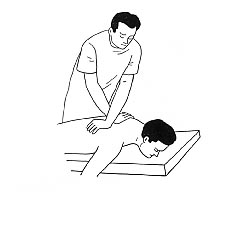
Fig. 1:
Direct manipulation
The patient is
in prone position (fig. 1). The heel of the hand applies direct pressure on
the spinal column either over the transverse processes or the spinous processes.
The pressure is followed by a very quick release. These techniques are violent
and dosage is impossible. They are frequently disagreeable if not painful, and,
above all, their possibilities are extremely limited. They seem to us to be
of little value and to be dangerous.
Indirect
manipulation
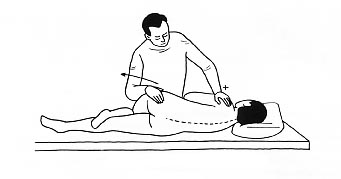
Fig.
2: Indirect manipulation
The operator utilizes
the natural lever arms of the body in order to act upon the spinal column. For
example, in a patient lying on his side (fig. 2) pressure applied in opposite
directions on the pelvis and on the shoulder will impose a movement of torsion
upon the lumbo-dorsal spine. Or as mentioned above, in moving the patient's
head the operator imposes motions upon the neck. A large number of maneuvers
allows manipulation of ail vertebral segments in all desired directions. These
maneuvers are gentle and progressive and mobilize the segment in question. They
have the great advantage that they can be tried out before they are actually
executed. The operator, by going as far as the phase of tightening, can establish
easily whether the maneuver is painless, and therefore feasible. This is very
important in the system of manipulation which we propose.
The precision of
these maneuvers can be increased by utilizing what we call semi-indirect maneuvers.
In these, the total movement is given at a certain distance (as in indirect
manipulations) but the operator can obtain a more precise localization of the
effect of the manipulation by using pressure and counter pressure at or below
the segment treated. Figure 3 shows an example of an assisted semi-indirect
manipulation in the low lumbar region.
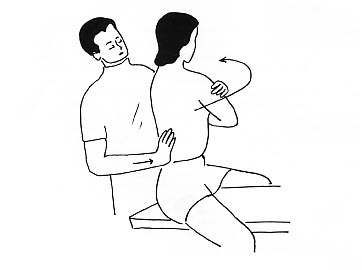
Fig.
3: Assisted semi-indirect manipulation in the
lumbar region
|
|
The
concept of painlessness and opposite motion |
|
We arrive now at
the primary problems of treatment by manipulation. Manipulation therapy should
not be given routinely on a vertebral segment, without consideration of the
individual clinical case. It is, for example, illogical to treat all the "painful
conditions of the low back" by three standard maneuvers routinely repeated
whatever might be the individual problem. Every case demands a particular maneuver
which has to be strictly adapted to its individual needs. Experience has shown
that while forcing of a painful spinal movement sometimes results in an improvement
accompanied by a sharp pain, this very frequently makes things worse. This is
logical. There is a reason for the pain or limitation of motion. Forcing against
this cause might overcome it, might, as is said frequently "break the adhesions",
but obviously in case of a mechanical obstacle, there is a great chance of provoking
irritation and inflammation which could make matters worse. We have seen this
in daily practice.
By contrast, experience
has also shown that in case a motion of the spinal column is limited, say in
its rotation to the left, and is free to the right, a forced rotation toward
the right will improve the condition, whereas one to the left will not. Thus,
a patient with a traumatic torticollis, unable to turn his head toward the left
but turning it freely to the right, will not be relieved of his pain by a forced
rotation toward the left, even under traction. However, he will be relieved
by a forced rotation of the head towards the right. This point is extremely
important because, following this principle, the physician can proceed without
pain. As confirmed by our experience this method is physiologic since it always
results in a liberation of the locked movement. This extremely important point
is the concept of painlessness and of opposite motion. It consists
of making the manipulation in the direction opposite to that which is painful
and limited. But, it is rare that it is only in one direction that motion is
locked. As is well known, spinal motions are inter-dependent. The manipulation
which is indicated is therefore the motion which will combine the various free
directions.
How
can the concept of painlessness and opposite motion be applied? It is to be
assumed that the patient has been completely examined, clinically and radiologically,
that all necessary laboratory studies have been done, and that the physician
has established a diagnosis. Manipulation like any other therapy cannot be done
without diagnosis. If it has been decided to use manipulation, how should one
proceed? The motions of the vertebral segment in question are studied and marked
as follows: one plus for a minor limitation; two plus for a moderate, and three
plus for a severe limitation.
 Example 1. An example of the limitations in a case of traumatic low
back pain could be as follows: flexion, +; extension, ++; rotation toward the
right, 0; rotation toward the left, +++ ; lateral flexion toward the right,
0; lateral flexion toward the left, + + +. This can be expressed in diagrammatic
form (diagram of motion) as in figure 4, the cross-bars indicating restriction
or pain. It is clear from figure 4, and is shown in figure 5, which manipulation
is to be done—rotation to the right in right lateral flexion.
Example 1. An example of the limitations in a case of traumatic low
back pain could be as follows: flexion, +; extension, ++; rotation toward the
right, 0; rotation toward the left, +++ ; lateral flexion toward the right,
0; lateral flexion toward the left, + + +. This can be expressed in diagrammatic
form (diagram of motion) as in figure 4, the cross-bars indicating restriction
or pain. It is clear from figure 4, and is shown in figure 5, which manipulation
is to be done—rotation to the right in right lateral flexion.
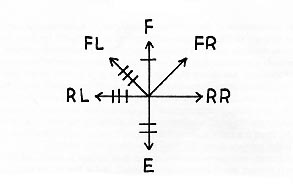
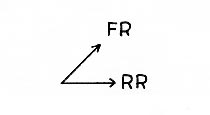
Fig.
4: Diagram of motion for the case of example
1. F, flexion ; E, Extension ; FR, right lateral flexion ; FL, left lateral
flexion ; RR, rotation of the right ; RL, rotation to the left. Number of crosslines
indicates severity of the limitation.
Fig.
5: Manipulation diagram for the case of example 1. FR, right lateral
flexion ; RR, rotation to the right.
 Example 2. Figure 6 shows a similar diagram constructed on the basis
of the examination of a painful neck. The manipulation will be a rotation toward
the left in left lateral flexion and flexion as indicated in figure 7. Several
techniques could be utilized successively by combining these directions in several
ways— for example, first a manipulation acting more particularly in rotation
toward the left, then another one acting more particularly in lateral flexion
to the left and finally a flexion technique.
Example 2. Figure 6 shows a similar diagram constructed on the basis
of the examination of a painful neck. The manipulation will be a rotation toward
the left in left lateral flexion and flexion as indicated in figure 7. Several
techniques could be utilized successively by combining these directions in several
ways— for example, first a manipulation acting more particularly in rotation
toward the left, then another one acting more particularly in lateral flexion
to the left and finally a flexion technique.
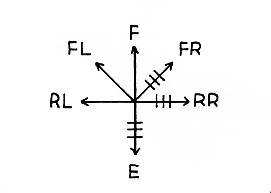
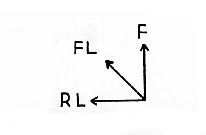
Fig.
6: Diagram of motion for the case in example 2. F, flexion ; E, extension
; FR, right lateral flexion ; FL left lateral flexion ; RR, rotation to the
right ; RL, rotation to the left. Number of crosslines indicates severity of
the limitation.
Fig.
7: Manipulation diagram for the case of example 2. F, flexion ; FL,
left lateral flexion ; RL, rotation to the left.
 Example 3. Figure 8 shows the diagram of another case. In this instance,
all the motions are limited or painful, and manipulation is contra-indicated.
Example 3. Figure 8 shows the diagram of another case. In this instance,
all the motions are limited or painful, and manipulation is contra-indicated.
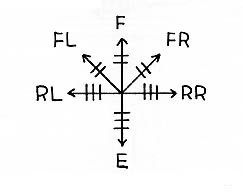
Fig. 8: Diagram
of motion for the case of example 3. F, flexion ; E, extension ; FR, right lateral
flexion ; FL, left lateral flexion ; RR, rotation to the right ; RL, rotation
to the left. Number of crosslines indicates severity of the limitations.
 Example 4.
In certain cases it is not easy to establish clearly whether there is limitation
of motion and the pain is only slight. This is the procedure: we attempt the
manipulation without actually performing it completely. In other words, we execute
the first two phases of the manipulation, positioning and tightening, first
in rotation toward the right, then in rotation toward the left, in lateral flexion
right and left, in flexion and finally in extension. Thus, we can recognize
clearly the motions that are hindered or uncomfortable for the patient.
Example 4.
In certain cases it is not easy to establish clearly whether there is limitation
of motion and the pain is only slight. This is the procedure: we attempt the
manipulation without actually performing it completely. In other words, we execute
the first two phases of the manipulation, positioning and tightening, first
in rotation toward the right, then in rotation toward the left, in lateral flexion
right and left, in flexion and finally in extension. Thus, we can recognize
clearly the motions that are hindered or uncomfortable for the patient.
Application in cases of sciatica
Many cases of sciatica can be treated by manipulation, especially those due
to reversible protrusion of an inter-vertebral disk. Manipulations should not
be routinely the same in all cases, but should again be adapted to every individual
case. The determining factor is the accompanying scoliosis. We might distinguish
two classes of sciatica, depending upon the associated scoliosis which is either
convex (fig. 9) or concave (fig. 10) to the side of the sciatica. An example
of each class is given.
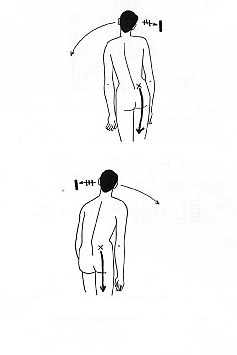
Fig.
9: Sciatica with convex scoliosis
Fig. 10: Sciatica with convave scoliosis
Example 5. Right
sciatica with scoliosis convex to the side of pain (fig. 9). Lateral flexion
toward the left is free; lateral flexion toward the right is locked; rotation
toward the left is free; rotation toward the right is locked. In general, extension
is locked and flexion is rather free (fig. 11). The manipulation will be a rotation
toward the left with lateral flexion toward the left on the spine in flexion.
Various techniques can be used.
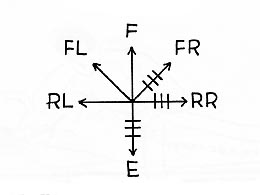
Fig.
11: Diagram
of limitations for the case in example 5. F, flexion ; E, extension ; FR, right
lateral flexion ; FL, left lateral flexion ; RR, rotation to the right ; RL
rotation to the left. Number of crosslines indicates severity of the limitation.
1.A very good technique is shown on figure 12. The patient lies on his/her painful
side, the left hip and knee flexed.
-
First
phase, positioning—the operator, with his left hand, stabilises
the left shoulder of the patient and keeps it immobile during the entire maneuver.
With his right forearm he leans on the left ischium of the patient.
-
Second
phase, taking up the slack—applying pressure to the ischium,
the operator rotates the left half of the pelvis and brings the lumbar segment
into a pronounced kyphosis.
-
Third
phase, thrust—having made sure that the tightening is complete,
he continues the mo veinent of his right forearm, exag-gerating it by a brisk
extra thrust.

Fig. 12: Example 5. First
manipulation technique.
2. The astride technique
is illustrated in figure 13. The operator brings the spine into a slight flexion
and a pronounced left lateral flexion before executing the rotation toward the
left.

Fig. 13: Example
5. Third manipulation technique (strap technique).
3. Provided the
patient can assume the prone position, a third technique can be used as shown
in figure 13. The patient's pelvis is strapped to the table. The operator rotates
the lumbar spine toward the left (i.e., the non-painful side) while he flexes
it strongly toward the same side by pulling the patient toward himself away
from the table.
Example 6. Right sciatica with scoliosis concave to the side of pain
(fig. 10).

Fig.
14: Diagram of limitations for the case of example 6. F, flexion; E,
extension; FR, right lateral flexion; FL, left lateral flexion; RR, rotation
to the right; RL, rotation to the left. Number of crosslines indicates severity
of limitation.
In this case, the schema
is: left lateral flexion is locked; right lateral flexion is free; left
rotation is locked; right rotation is free (fig. 14). Actually in this type
of case, extension is usually free and flexion is limited. However there are
cases m which the opposite is true, necessitating a change in technique. In
the given example, the following techniques can be used.
-
1. The patient lies
on his non-painful, i.e. his left side, left hip extended, right hip and knee
flexed (fig. 15). The physician stabilizes the patient's shoulders perpendicular
to the table with his right hand. He applies his left hand firmly on the right
iliac crest, as if he wanted to rotate it anteriorly (fig. 15). This will
rotate the lumbar segment and bring it in lordosis (extension). The operator
puts the region on a stretch and then executes the thrust.
 Fig. 15:
Example 6. First manipulation technique
Fig. 15:
Example 6. First manipulation technique
-
2. In the astride
technique, the operator brings the spine into lateral flexion toward the right,
this being the side of free motion.
-
3. In the strap
technique, the operator stands at the painfui side, the right in the given
example (fig. 16). By pulling the patient toward himself and away from the
table, he brings the spine in right lateral flexion and more or less rotation.
There techniques must aiways be done by going through the three mentioned
phases: positioning, tightening and thrust. Under no circumstances should
the patient experience any pain during the entire maneuver. If one of the
executed movements were painful this would mean that the direction of the
motion is wrong. If all movements are painful, manipulation is contra-indicated.

Fig. 16: Example 6. Third manipulation technique (strap technique)
A full discussion
of indications and results would require much more space than can be given to
it here, because the actual manipulations which would be indicated (in cases
of sciatica, back pain, cervico-brachial radiculopathy, etc.), would change
with the clinical variation of every individual case. In certain cases, manipulation
represents the treatment of choice, irreplaceable because of the quality and
the speed of the results, which are sometimes instantaneous. In other cases,
manipulation represents only an addition to other treatment, either physical
or chemical. Even so, it may still be an important part of the over-all management.
The most important of the
common indications for spinal manipulation are acute or chrome pain of the lower
or the upper back, common sciatica, chronic cervical pain with limitation of
motion and cervicobrachial radiculopathy. We find that manipulations are generally
indicated in all those reversible and minor mechanical derangements (dysfunction)
of the intervertebral joints, which have resulted in local or radicular pain
or in involvement of the sympathetic nervous system. Junghanns calls the intervertebral
joint a "motion segment." This motion segment includes the intervertebral
disc, the posterior joints and the intervertebral ligaments. Together with other
German authors, he insists upon the importance of the role played by the lesions
of the small menisci between the posterior joints in the mechanical pathology
of the vertebral column.
Our enumeration of the indications for manipulation is incomplete because it
would require a special and detailed analysis to discuss the exact applications
in every individual case. If we take, for instance, acute low back pain, we
note that results are better in cases originating from a muscular effort or
inappropriate movement than in those without a mechanical cause.
If we classify low back
pain in two classes, according to the presence or absence of a grossly obvious
antalgic posture, we find such antalgic deviation of the spine in 75 cases out
of 100. Among these 75 cases, 40 have a scoliosis with convexity toward the
side of pain, 25 have a scoliosis with a concavity toward the side of pain,
10 have a pronounced lumbar kyphosis. The 25 cases without spinal deviation
present only moderate rigidity. In 20 of these patients, the spine cannot flex,
whereas extension is free. In 5 cases, the patient is in a slightly flexed position,
but he can neither extend nor further flex his spine. In these groups we find
that one or two manipulations will result in complete disappearance of the pain
in a considerable percentage of cases as indicated in table 1. It is well known
that acute low back pain can disappear spontaneously in a relatively short time.
Any new form of treatment should therefore produce either immediate or very
rapid relief in order to be considered effective. For this reason only those
cases in which immediate relief was obtained after one or two manipulations
are included in the percentile figures in the third column of table 1. If a
second manipulation was needed, it was aiways done 48 hr. after the first.
We have grouped 240 cases
of chronic low back pain in three groups according to treatment procedures which
consisted of: 1) manipulation alone, 2) manipulation and therapeutic exercises,
3) therapeutic exercises alone. Our conclusions are as follows:
-
Group 1. In
73 per cent of the cases, complete disappearance of the pain occurred after
one to six manipulations distributed over a period of from 1 to 20 days. After
4 months, good results were maintained in only 40 per cent of the cases. Repeated
manipulations, however, produced again the same good results as were obtained
originally. Most of these patients had suffered for a long lime and had previously
received numerous other forms of treatment.

Table 1
-
Group
2. In addition to the manipulation, individually prescribed therapeutic
exercises were donc by the patient daily for 4 to 5 minutes. Good results
were obtained by this treatment in 72 per cent of the cases early and in 79
per cent after 4 months.
-
Group
3. Therapeutic exercises were given without manipulation or any other
treatment. After 20 days, 28 per cent were without pain and after 6 weeks,
45 per cent. After 4 months 55 per cent were without pain. However, the improvement
was not as complete as in the cases treated by manipulation. Very frequently,
there remains a certain discomfort or a painful point, usually eliminatcd
easily by manipulation. It should be noted that, even if the exercise program
is restricted to a minimum, it is difficult to have a poorly motivated patient
do the exercises regularly.
These statistics
illustrate the value of manipulation in one of its most frequent indications.
We combine manipulation rather frequently with numerous other treatments depending
on the individual case, such as injection of the ligaments, massage of painful
points of muscles and skin, thermotherapy, electrotherapy, hydrotherapy and
in some cases also X-ray therapy. But in most of these cases, manipulation is
the mainstay of the treatment because in its absence, rapid and complete improvement
is rare. On the other hand, manipulation is not always sufficient. Therefore,
we frequently complement it by the treatment of ligaments which have remained
painful, by correction of static deficiencies, by muscle reeducation, and by
a correction of postural or occupational habits. In the medical service of a
railroad company, where it is very easy to control patients over long periods
of time, the introduction of manipulation in daily practice has allowed us to
reduce by 40 per cent the number of workers' days of absence from work due to
mechanical involvement of the lumbar spine, such as low back pain, sciatica,
etc. We want to emphasize as a particular feature of our method of manipulation,
the promptness of its results, the frequently immediate and prolonged subsidence
of a long-standing pain or limitation.
Without being able
to discuss in detail all the indications which we have mentioned, we would like
to elaborate on a less well known indication in which this method is of particular
value—this is in the cervical syndrome, whether it is caused by trauma
such as a minor form of whiplash injury, by a rheumatic involvement, by degenerative
arthritis of the cervical spine or simply by a postural defect. All these manifestations
have been described in 1925 by Barre and Lieou under the name of Posterior Sympathetic
Cervical Syndrome. This syndrome includes headache, vertigo, tinnitus, visual
fatigue, a tendency to depression, etc. There is much controversy as to the
pathogenesis of these symptoms. At present, many insist upon the important role
played by the vertebral artery. We would like to mention the great value in
the treatment of this syndrome of gentle and well selected manipulations applied
according to the method that we have outlined. These procedures confirm the
role of small, reversible, mechanical derangements in the production and maintenance
of a large number of these complaints.
We would also like
to mention the very good results which we have obtained in coccygodynia caused
by a fall on the pelvis or after childbirth. Among 187 cases treated (with a
follow-up of 2 years), 87 per cent have been cured after two or three manipulations.
We have developed a new method of manipulation for coccygodynia, which has many
advantages over the classical procedure. In our method the patient lies face
down. The physician enters the right index finger into the rectum and places
the anterior surface of this finger against the anterior surface of the coccyx.
He then applies pressure to the sacrum with the heel of his left hand. The pressure
is applied slowly and forcefully, while the right index finger remains against
the coccyx without applying any pull. Pressure on the sacrum is maintained for
40 to 50 sec. The essence of this new method of manipulation is the application
of the manipulating pressure to the sacrum rather than the usual method of manipulating
and pulling the coccyx itself.
These examples
cannot give a complete review of the therapeutic possibilities of the manipulative
method which we have proposed. They are given here simply as illustrations of
its value, provided it is applied carefully and all diagnostic precautions have
been taken.
References
BARRE, J., LIEOU, A. Syndrome sympathique cervical posterieur. Paris
Med., 15: 266-269, 1925.
MAIGNE, R. Les Manipulations vertebrales. Paris, Expansion Scientifique
Française, 1960.
MENNEL, J. B. The Science and Art of Joint Manipulation, Vol. 1 and 2. London,
J. and A. Churchill, 1949.
SCHMORL, G. JUNGHANNS, H. Die gesunde und die kranke Wirbwelsäule in Kontgenbild
und Klinik. Stuttgart, Georg Thieme Verlag, 1957.
